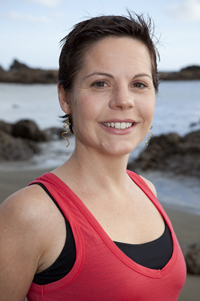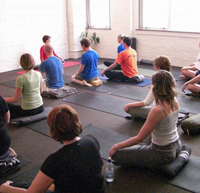by Kelly Fisher, Urban Yoga
Typically when you finish your first yoga teacher training it can feel as though you’re bursting with equal parts fantastic information to share and uncertainty about how or where to share it.
Unless you’ve completed teacher training with an organisation that rolls new teachers onto an existing schedule, it can be a challenge to figure out how you can get into teaching in your town.
Often studios will want teachers with previous teaching experience and/or specific training and other places that offer yoga as part of a wider fitness offering will have a long list of willing new teachers vying for the opportunity to cut their teaching teeth.
But all is not lost!
For those with lots of initiative, a touch of audacity and a little ingenuity, the way you launch your yoga teaching career can actually help to differentiate you from the ever-increasing number of people who seem to want to teach yoga these days.
Perhaps one of the ideas that have worked for me in the early days of my teaching or the people I’ve mentored since then will help you figure out how to get your teaching career going.
Here’s six insights on how to land your first yoga teaching job.
1. Begin teaching yoga NOW
It’s incredibly important to start teaching as soon as you can after finishing yoga teacher training so that your enthusiasm is still high enough to mitigate the inevitable bouts of shaky confidence that we all experience now and then. Waiting and pondering and planning for too long are surefire ways to undermine yourself.
While the training is still fresh in your mind, start voicing instructions as soon as you can, even if you haven’t got a yoga job yet.
I know one person who was so determined to hone her voice that she began by teaching stuffed animals in her living room.
By the time she got up in front of her first real class, she sounded much more experienced than she actually was and the students had no idea they were her first real group.
You don’t have to go that far though. It’s great to start with trusted friends and family members as your first students just so you can have the experience of voicing your instructions and having other people follow them.
If you’re in the rhythm of teaching even one person or stuffed toy on a regular basis, then when the opportunity for a group of students presents itself, you will be much more ready than if you have to start from cold again.
2. Focus on the familiar
At the end of my first teacher training, I felt so compelled to teach that I would have moved mountains to be able to do it. The studio I practiced at was unwilling to add classes to the schedule to accommodate a new teacher but I couldn’t imagine teaching anywhere else.
After some negotiating with the owner, I was allowed to hire the space on Sunday mornings to teach a group of friends I had gathered.
Because I was familiar with the room, my comfort level was higher than if I’d tried to teach in a strange place. All of the initial students were friends of mine and it helped my confidence to feel that unconditional support from them.
Added bonus: No one else was offering Sunday morning classes in my town. Word got out that I was teaching then so people other than my friends started turning up to my class. My confidence was able to increase even further in a really natural, organic way to the point that Sundays became my wee niche.
Even after I started my first studio and was teaching heaps of classes, Sunday mornings were my most popular time slot. To this day almost a decade later, many of my most faithful students originate from that first time slot I negotiated with the studio owner who wouldn’t put me on his regular schedule.
3. Think outside the box (or studio or gym)
Start teaching yoga wherever you are on a regular basis. Offering classes to your work mates or to fellow club members can be a good way to launch into teaching and build confidence without facing a group of total strangers. At the same time, you could be carving out a yoga offering that is unique in a world where there seems to be a yoga class on every corner.
Some folks I know have negotiated use of the boardroom at their place of work during pre-work or lunchtime hours.
A quick email out to the co-workers has gathered a small, but perfectly formed group of new students. When you first start teaching, it can be helpful to have only a handful of people at any one time. It helps you to develop the capacity to see what the people in the room are doing in response to your instructions.
Don’t let convention or rules or what’s been done before stop you.
One person I know started to offer yoga classes in what was essentially a storage closet with a window at the University where he worked – despite the fact that yoga classes had failed on campus in the past. He had a strong desire to teach and access to the space so he decided to give it a go anyway. He charged a nominal fee and started with a couple of classes a week.
Four years on, he’s still at it with consistently enviable class numbers and a student base that also comes to his classes and workshops at other places in town now that he’s offering more.
Another woman started teaching yoga in the hour before her weekly tramping club meeting in the space where the meetings were held. The group were ideal candidates for starting yoga as a support for their shared hobby.
Because the new teacher was a well-known member of the group and she chose to offer classes when and where many people could easily get to them, she had herself her very own student base in no time. Her familiarity with the challenges the club members faced with their bodies as a result of frequent long walks in the woods meant she could tailor her classes to meet their needs specifically.
She thereby made a potentially intimidating practice accessible for a group of people who could really use it – huge yoga win!
4. Begin with beginners
One of the most challenging aspects of starting to teach is having the confidence in what you’re offering. Yoga beginners have few preconceived ideas about how a class “should” be and therefore tend to be very open which makes a new teacher’s job much more pleasant.
That being said, keep in mind that beginners can be a little more challenging for the exact same reason. They are reliant on you, the teacher, to be able to go through the yoga practice safely and end up feeling good at the end of it.
The upside of this is that you get to see very clearly where your instructions are working well and where your words need work. For the most part, beginners are earnestly trying to follow what you say and in the interest of mutual support, I’ve found that new teachers quickly learn to say it well enough that the students have success.
One of the fastest routes to honing your own voice as a teacher is to do so with a group that has no one else’s instructions going through their heads.
5. Don’t teach for nothing, ie. always teach for something.
Teaching yoga is an exchange of energy. Chances are you have invested quite heavily in your teacher training and regardless of how inexperienced you are, what you offer in the context of teaching yoga has value. You have to recognise that and stand by it before anyone else will accord you the same respect.
The sad truth is people often only value what they have to exchange for something else, either money or goods or services. You don’t necessarily have to charge market rate or even a set fee but it is absolutely imperative to expect something from the students in the form of returned energy.
I know a pair of teachers who started pay-what-you-can classes in an unorthodox venue because they truly wanted to make yoga accessible to people who couldn’t afford to go to studio or gym classes. Sometimes their payments would take the form of tomatoes out of a student’s garden, a handwritten poem or a beautiful piece of original art. I had the privilege of covering some of those classes and I have yet to see a more beautiful, engaged and appreciative group culture anywhere.
Making sure your time and knowledge is being recognised by the students benefits the both of you. It benefits the students by instilling an appreciation for what you’re offering and offers them the dignity of meeting you as an equal.
It’s funny, I’ve taught some corporate classes where the organisation paid me for teaching and other corporate classes where the students themselves had to pay at least a portion of my fees. Invariably, the students who had to pay even a small amount out of their own pocket engaged much more deeply with the practice and took much more ownership of it over the long haul.
As for you, receiving something in exchange for teaching benefits you in that feeling appreciated is one of the surest ways to stay motivated to keep learning and offering more.
This helps you to avoid yoga teacher burnout, which is becoming all too common. It’s not desirable to be a martyr yoga teacher, suffering and starving for the privilege of teaching. No one benefits from that long-term.
Our profession has the potential to empower people and support them in all of the things they do in the world. We have to stay energetic and well enough to keep showing up for them so that they can keep showing up in whatever forms of service their own lives take. That means getting support for teaching in the form of money or other usable resources.
6. Know why you want to teach yoga
Teaching yoga well is a worthwhile pursuit and one that takes commitment and determination. If you know why you want to teach yoga, it helps you to stay the course when things get challenging.
What do you hope to offer the students who come to you and can you tie it back to one of your core values?
The clearer and more specific you are on your ‘why’ and the closer it is to your heart, the more resilient you’ll be as you strive towards the how of it.
Teaching yoga is the most challenging job I’ve ever done and it’s worth every single struggle, disappointment and frustration I’ve experienced in doing it.
For me, it is an absolute privilege to be a positive part of someone’s day when much of the rest of the world seems to be the opposite much of the time. Offering folks a chance to turn inward for empowerment, for solace and for nourishment using their body as a tool feels like a gift.
I am perpetually grateful that I have the opportunity to take people beyond the noise of the world and the chatter of their minds into their timeless essential nature simply by offering them a yoga class.
I am blessed to share in students’ triumphs and joys and humbled when they credit their practice with making those things possible. I only get to do that because I stayed the course over a long period of time. It didn’t happen overnight because yoga is not a magic bullet. It is an alchemical process that has a wisdom and timing of its own.
When you step into a teaching role, your ability to keep showing up models a faith in the process of yoga and demonstrates a maturity that will inspire others to stay the course as well.
At the beginning of my first teacher training, I had absolutely no intention to teach when I finished the course. I simply wanted to immerse myself in yoga practice and study. By the end of 350 hours and eight weeks, I’d found my vocation. If you’ve read this far,then chances are you have too. Welcome to the next leg of your journey. You’re in for a transformative ride!
If you have any questions or comments about this article, please contact Kelly direct by sending her an email.
About Kelly
 Kelly Fisher, e-RYT 500, has made yoga her full-time career since 2005 having spent most of the previous decade in big business IT and part of the decade before that studying Neuropsychology.
Kelly Fisher, e-RYT 500, has made yoga her full-time career since 2005 having spent most of the previous decade in big business IT and part of the decade before that studying Neuropsychology.
She is the owner of Urban Yoga, the co-founder of Yoga Unlimited,Wellington’s first upmarket yoga and wellness retreat and the catalyst behind Wellington’s offering of the first couple of years of the Global Mala event.
Over the course of her yoga career, Kelly has studied with many teachers from various lineages including Iyengar, Astanga, Satyananda, Prana Flow and Anusara and has investigated related sciences Ayurveda, Acupuncture and Craniosacral therapy. She is grateful for the support and advice she has had on her journey. Contact Kelly here.


